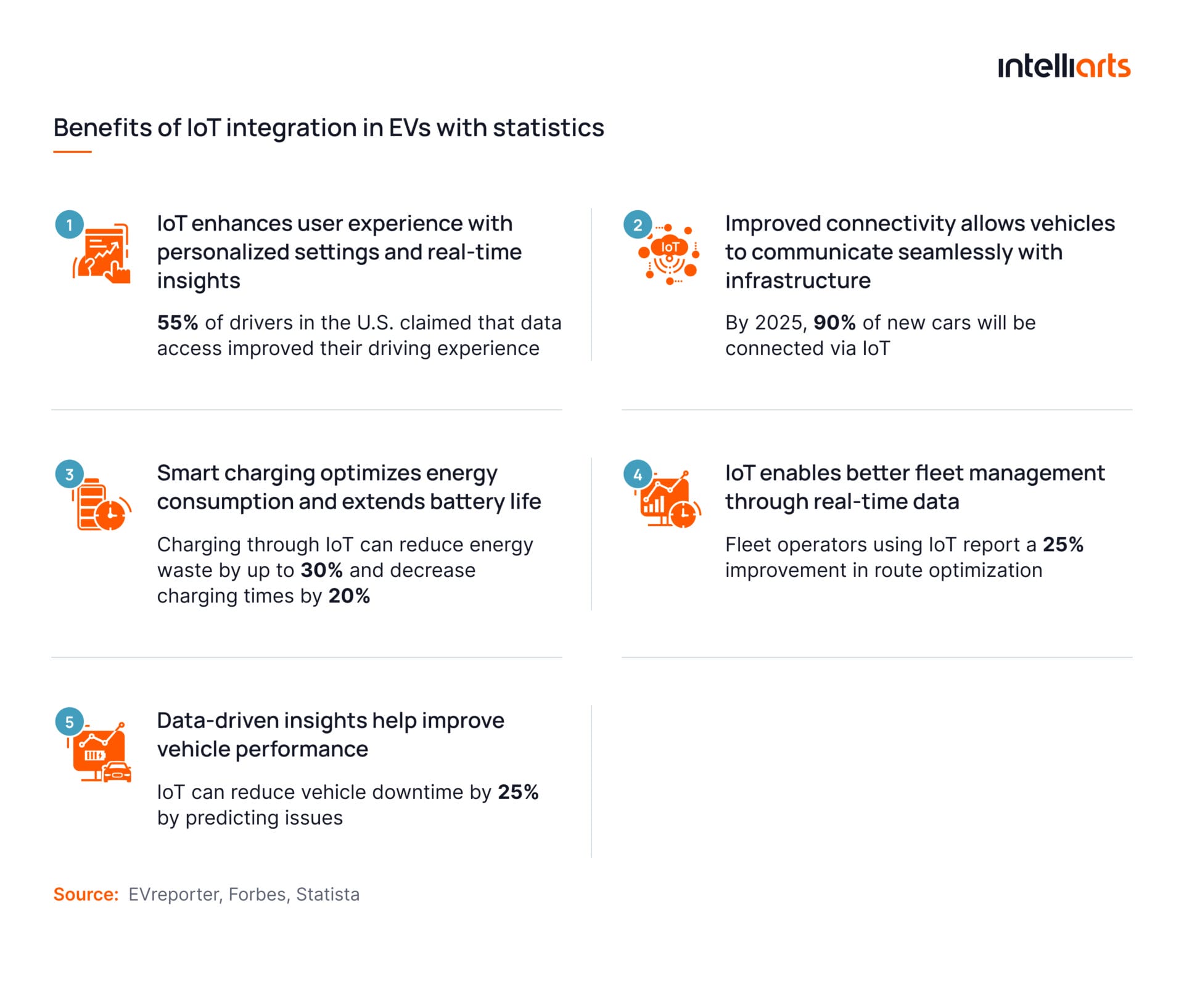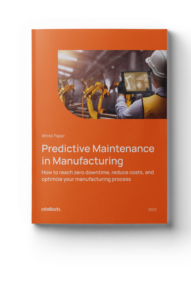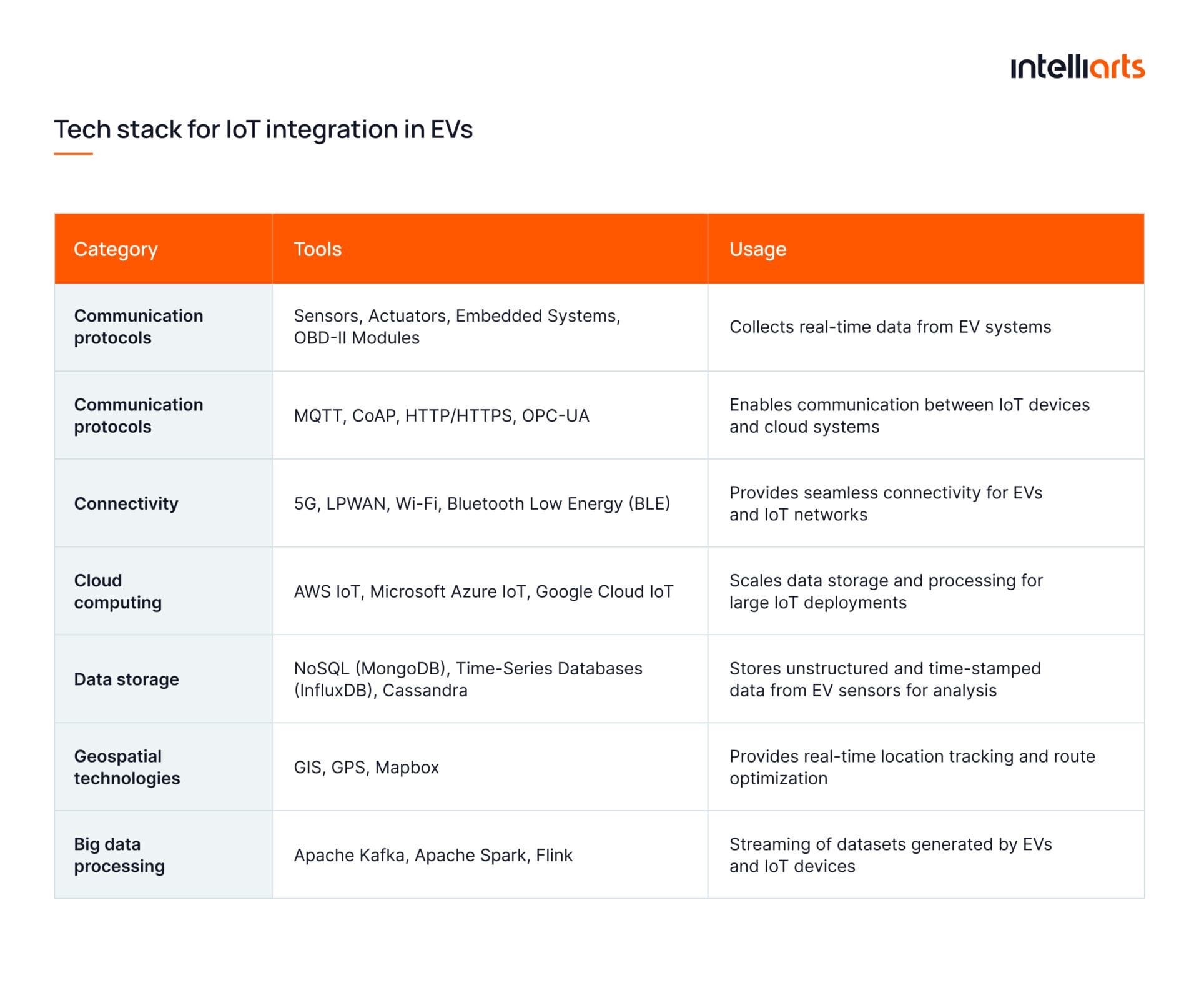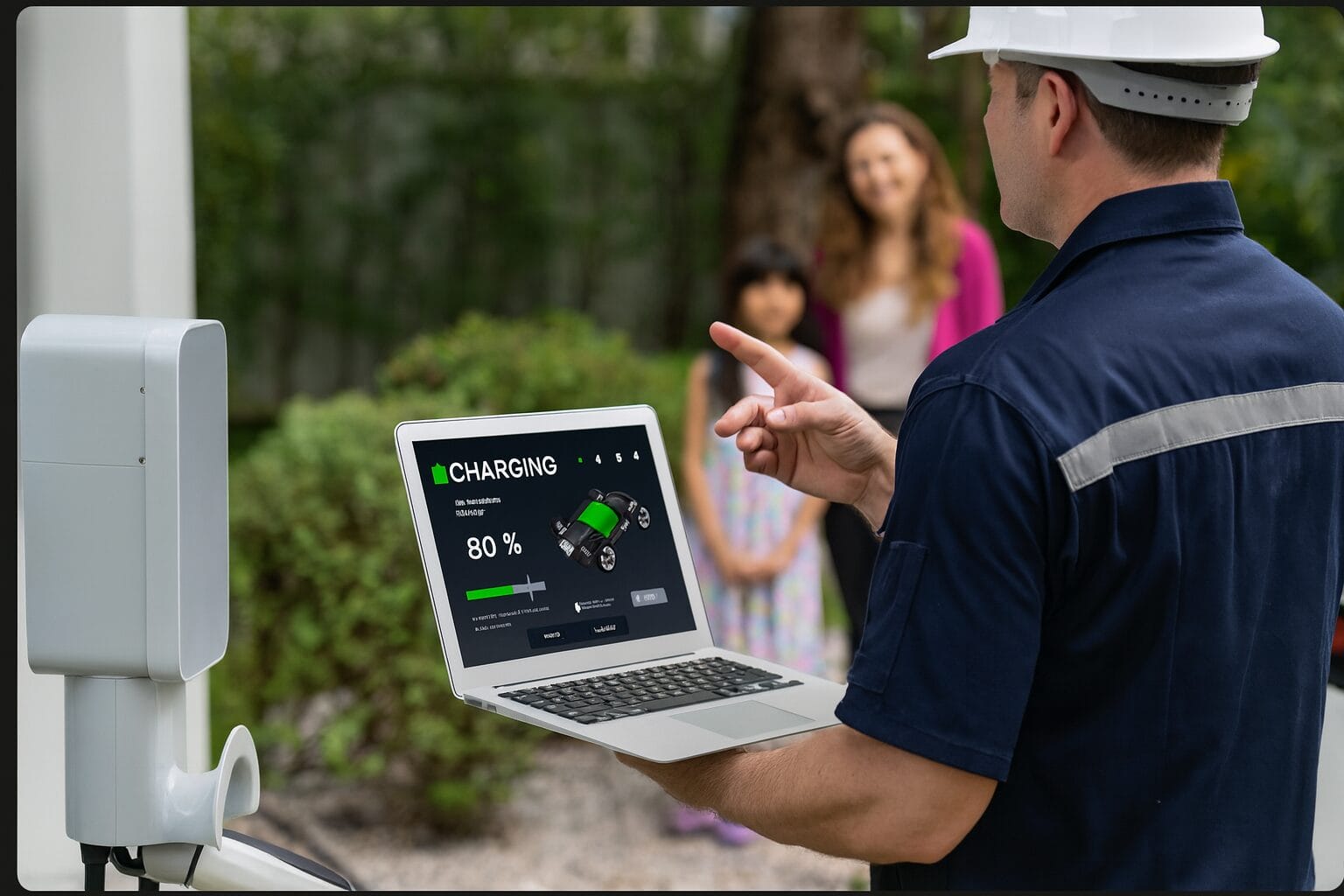The niche of smart devices is booming, mostly due to their usefulness across industries, including electric vehicles. From a stream of big data and smart charging to predictive maintenance and fleet management, IoT in electric vehicles can offer it all for both businesses and end users and more. You probably are curious about how your EV company exactly can put IoT to good use, just like 48% of enterprises that utilize IoT rarely. Well, there are many ways.
In this post, you’ll discover the main benefits of utilizing the Internet of Things in the EV industry, discover key features of IoT in EVs, explore the specific tech stack, and review relevant challenges and practical solutions to them. Additionally, you’ll explore three success stories related to IoT applications in electric vehicles.
Benefits of IoT integration in EVs
Increased digitalization on every level and across most industries is proven to be advantageous overall. This trend is evident in both the automotive sector and renewable energy initiatives, such as IoT for solar energy projects. As such, the main benefits of adopting IoT EVs and the real-life statistics backing them up are shown in the infographic below:

Main uses of IoT in the EV industry
Now, let’s explore some of the many IoT applications in electric vehicles:
1. Real-time data acquisition. IoT enables the collection of real-time data from electric vehicles, including location, speed, battery status, and driving habits. This data helps improve performance and efficiency by making adjustments in real-time.
Example: Nissan’s LeafConnect collects real-time data to monitor battery health, provide maintenance alerts, and optimize energy consumption.
2. Predictive maintenance. IoT devices monitor vehicle components such as batteries and motors to predict issues before they occur, minimizing breakdowns and reducing repair costs.
Example: Bosch IoT Suite provides predictive maintenance solutions, detecting potential issues in electric vehicle systems and improving fleet performance.
3. Smart charging and energy management. IoT for EV charging market optimizes energy consumption by monitoring and adjusting the charging process, balancing energy loads, and integrating renewable energy sources.
Example: ChargePoint uses IoT to provide smart charging solutions that improve charging efficiency and reduce energy waste.
4. Fleet management. IoT enables real-time tracking, route optimization, and vehicle diagnostics, improving operational efficiency for companies managing EV fleets.
Example: Geotab’s Fleet Management enhances fleet operations by offering real-time monitoring and route optimization.
5. Remote vehicle monitoring and control. IoT allows users or fleet managers to monitor and control electric vehicles remotely, adjusting charging schedules and managing vehicle performance from anywhere. Example: BYD’s FleetLink provides remote monitoring and control capabilities to improve the efficiency of electric fleet management.
As can be seen from the examples, the tendency towards the usage of IoT is the optimization of report usage, sustainability, and minimization of potential process disruption and downtime risks. For companies looking to reduce maintenance disruptions, EV maintenance solutions offer a comprehensive approach.
Applications of IoT extend far beyond the EV industry. As the IoT for EV industry and supply chain continues to evolve, it’s high time to explore the usage of IoT in supply chain management additionally.
Tech stack for IoT integration in EVs
From a certain point of view, IoT in electric vehicle integration is another software component and, respectively, a layer of complexity added on top of an existing solution, such as a mobile app or platform for electric vehicle fleet management.
Here’s a table with tools necessary to enable an IoT in electric vehicle industry integration categorized by categories:
Important note: The listed categories of tools are specific for IoT for electric vehicles integration and don’t include other necessary, for general development process, categories like UI/UX, DevOps, development frameworks and languages, etc.
Challenges of IoT in the EV industry and how to solve them
Let’s review the major concerns of businesses aiming to adopt IoT electric vehicles and ways to address them:
#1 Integration with legacy systems
Many automotive companies still rely on older infrastructure and software, which may not be compatible with modern IoT platforms. This creates a significant barrier to adopting IoT technologies, as legacy systems often lack interoperability.
Solution:
- Implement middleware solutions to bridge the gap between legacy systems and IoT platforms.
- Adopt a gradual migration to more adaptable cloud-based architectures.
#2 Data security and privacy concerns
IoT in EVs generates vast amounts of data, including location, usage, and personal driver information. Ensuring this data is secure and managing compliance with privacy laws (e.g., GDPR) is a major concern.
Solution:
- Employ end-to-end encryption to protect data in transit and at rest.
- Regularly update software and firmware to patch vulnerabilities.
- Conduct security and technology audits.
Download an IT audit checklist
#3 High infrastructure costs
Setting up the necessary IoT infrastructure, including sensors, connectivity, and data processing units, can be costly. This is especially challenging for smaller companies or those entering the market.
Solution:
- Leverage cloud-based IoT platforms to minimize upfront hardware costs.
- Utilize a scalable infrastructure that can grow as demand increases.
#4 Connectivity and network reliability
Maintaining reliable connectivity, especially in remote areas, is critical for EV operations. Connectivity failures can lead to loss of real-time data or even vehicle control issues.
Solution:
- Use hybrid connectivity solutions, such as combining 5G, Wi-Fi, and satellite communications to ensure continuous connectivity.
- Implement edge computing measures.
#5 Data overload and management
IoT devices generate massive amounts of data, and managing, storing, and analyzing this data in a meaningful way can overwhelm existing infrastructure.
Solution:
- Use cloud storage solutions with scalable storage capacity.
- Adopt data compression techniques to manage bandwidth and storage requirements.
You may discover more about big data collection and management in another blog post by Intelliarts.
#6 Standardization issues
The lack of industry-wide standards in the EV IoT sector can lead to compatibility issues between devices, software, and platforms. Standardization issues in IoT-enabled EVs must be addressed to ensure smooth communication between IoT devices, EVs, and third-party platforms.
Solution:
- Follow industry standards toward data formats in the IoT sector.
- Utilize open-source IoT frameworks and protocols to foster interoperability between devices.
As we address these concerns, it’s essential to also consider key challenges in implementing IoT-based fleet management for EVs. Some of these include real-time data collection from fleets, smooth integration of multiple IoT devices, and managing large-scale data.
Best practices for implementing IoT in the EV industry
The Intelliarts team, as experts in e-mobility solutions, have their way with IoT in electric vehicles. Some of the best practices we follow include:
#1 Securing data throughout the entire flow
We believe that secure communication protocols like MQTT and TLS encryption must be employed to safeguard data exchanged between EVs, charging stations, and cloud platforms. With EV charging data analytics, these security measures help ensure the integrity of real-time charging data, optimizing energy distribution and station performance. Additional measures we utilize include implementing Public Key Infrastructure (PKI) and secure boot processes to ensure system integrity.
#2 Utilizing scalable cloud infrastructure
Since in-house server infrastructure is nearly obsolete among recently emerged companies and startups, leveraging cloud platforms is key. When it comes to IoT for the electric vehicles industry, cloud-based IoT projects in EV cars help streamline data collection, storage, and analysis. These often have to be scaled as the number of devices in the network and the amount of reports for analysis grow. We recommend AWS IoT or Microsoft Azure as cloud service providers as they offer scalability to manage the growing data from EV fleets while supporting real-time data analytics and predictive maintenance.
#3 Prioritize interoperability and standardization
To ensure smooth integration of IoT systems across various EV platforms, companies should follow industry standards like ISO 15118 (for vehicle-to-grid communication) and adopt communication protocols (e.g., CoAP, HTTP). Interoperability allows seamless connection between IoT devices, EVs, and third-party platforms.
The major difficulty of established EV companies that are digitalizing their fleets and infrastructure is the interoperability of data and report formats across their and their partners’ vehicles. Challenges with communication protocol incompatibility are also not unheard of. That’s why unification and standardization are paramount.
— Oleksandr Stefanovskyi, an ML team lead at Intelliarts.
Integrate predictive maintenance and analytics
Since big data supplied by IoT has to be utilized for decision-making, the right approach is to apply ML models (e.g., TensorFlow, PyTorch) compatible with IoT sensors. They can enable real-time monitoring and predictive maintenance needed to reduce downtime and improve EV performance. Advanced analytics can forecast component failures and optimize charging patterns for fleet management.
You may be additionally interested in exploring the usage of IoT in smart grid technology.
Real-world examples using IoT in the EV industry
Here are two examples of companies implementing software and Internet of Things in electric vehicle industry:
Creating next-gen EV fleet management software
Challenge: The EV charging company aimed to expand into the fleet management market by building a comprehensive IoT-based electric vehicle fleet management solution. This software is needed to track the fleet’s charging status — whether at depots, on-route, or at-home — and help reduce fleet operating costs. The solution was also expected to provide data analytics and predictions for charging times and energy usage.
Solution: Intelliarts delivered a powerful IoT EV fleet management solution that integrates real-time vehicle monitoring, predictive energy management, and telematics. Such an IoT in automotive solution offers fleet managers, among others, the ability to view current charging statuses, battery levels, and predictions of energy needs. It also allows for at-home charging compensation, with telematics tracking energy consumption and calculating costs.
Outcomes: The IoT technology in EV charging stations allowed for better fleet operational efficiency and charging flexibility. Key results include reduced downtime, optimized energy consumption during peak hours, and comprehensive data analytics to improve decision-making processes.
Explore IoT-enabled EV fleet management case study
Smart power management system for energy consumption optimization
Challenge: In this project, we were requested to help ensure that end users obtain more value from using our customer’s charging site goals. The goal was to optimize energy consumption, mitigate the effects of climate change, and maximize the cost-efficiency of stations.
Solution: Intelliarts delivered an IoT-based energy management system that allowed operators to schedule power limits, monitor energy use through data analytics, and manage costs by shifting charging loads to off-peak hours. The system included real-time energy monitoring, cost analysis features, and compliance with UK smart charging regulations.
Outcomes: The solution helped users optimize energy use, reduce costs by avoiding power demand surges, extend the lifetime of electrical infrastructure, and provide more reliable and eco-friendly service.
Explore smart power management case study
ABB’s IoT-based EV charging infrastructure
Challenge: ABB, a leader in power and automation technologies, needed to develop a scalable and efficient EV charging network. The goal was to create a smart charging infrastructure that could accommodate fluctuating energy demands and help operators optimize electricity usage.
Solution: ABB implemented an IoT-based EV charging system, which provides real-time monitoring of charging station performance, energy usage, and demand management. The system is integrated with data analytics tools that predict peak energy usage and allow operators to balance the grid by adjusting the charging loads dynamically.
Outcomes: The IoT-based solution resulted in increased energy efficiency by dynamically managing charging loads during peak hours and reducing operational downtime through predictive maintenance. ABB’s charging infrastructure helped reduce grid strain and provided EV users with a more reliable and efficient charging experience.
The future of IoT in the EV industry
IoT is evolving at an incredibly rapid tempo. Here are some of the IoT in EV usage that potentially become widespread in the next 5 to 10 years:
- Expansion of IoT Applications. We may predict a rise of IoT in areas such as Vehicle-to-Everything (V2X) communication or enhancing vehicle diagnostics.
- Data monetization: As IoT in EV data, which is by and large big data, becomes more valuable, companies will explore ways to monetize it. For example, owners of EVs can sell data generated by EVs to insurance companies, smart city developers, and energy providers who will use it for powering up data analytics and decision making.
- Sustainability and energy management: IoT can support sustainability efforts by optimizing energy consumption in EVs. Smart charging is already a trend. At the same time, sustainability is a huge concern. So, the prevalence of energy management practices for IoT in EVs is almost inevitable.
- Integration of AI and ML: Smart technology is already a cornerstone of many software solutions. Regarding IoT devices in EVs, AI and ML can power predictive maintenance, battery optimization, and autonomous driving features.
As you consider these future trends, you may be wondering: what is the progress in IoT-based EV vehicles? The integration of advanced technologies like IoT continues to push the boundaries of what’s possible. You can discover more about smart EV fleet management with AI and ML in another blog post by Intelliarts.
Final take
The integration of IoT in the electric vehicle industry offers transformative benefits like enhanced fleet management, smart charging, and predictive maintenance. However, IoT apps for EVs may be exposed to challenges such as legacy system integration and data security must be addressed. With future trends pointing toward AI integration and energy optimization, the IoT’s role in EVs will only expand, opening humanity the way for smarter, more connected electric transportation systems.
The adoption of IoT in electric vehicles requires substantial software development expertise as well as niche-relevant experience. Should you need assistance, consider Intelliarts as your trusted tech partner. With more than 24 years of market presence, delivering software solutions to varying business needs, we are ready, willing, and able to contribute to your best project.
FAQ
1. What are the primary challenges associated with integrating IoT into electric vehicles?
Integrating IoT into electric vehicles (EVs) presents challenges such as data security, high costs, and network connectivity issues. IoT in the electric vehicle industry also requires sophisticated infrastructure and real-time data processing for seamless communication between EVs, charging stations, and fleet systems.
2. What are the potential cost savings associated with adopting IoT-enabled electric vehicles for businesses and consumers?
IoT-enabled electric vehicles offer cost savings through optimized energy usage, predictive maintenance, and efficient route planning. Businesses benefit from reduced fleet management costs, while consumers save on fuel and maintenance, thanks to IoT applications in electric vehicles for real-time monitoring and analytics.
3. How does IoT technology improve electric vehicle (EV) fleet management?
IoT in EV fleet management enhances efficiency by providing real-time vehicle tracking, predictive maintenance, and energy consumption insights. IoT-based electric vehicle solutions help fleet operators optimize routes, reduce downtime, and improve overall performance, ensuring smoother operations for businesses.













